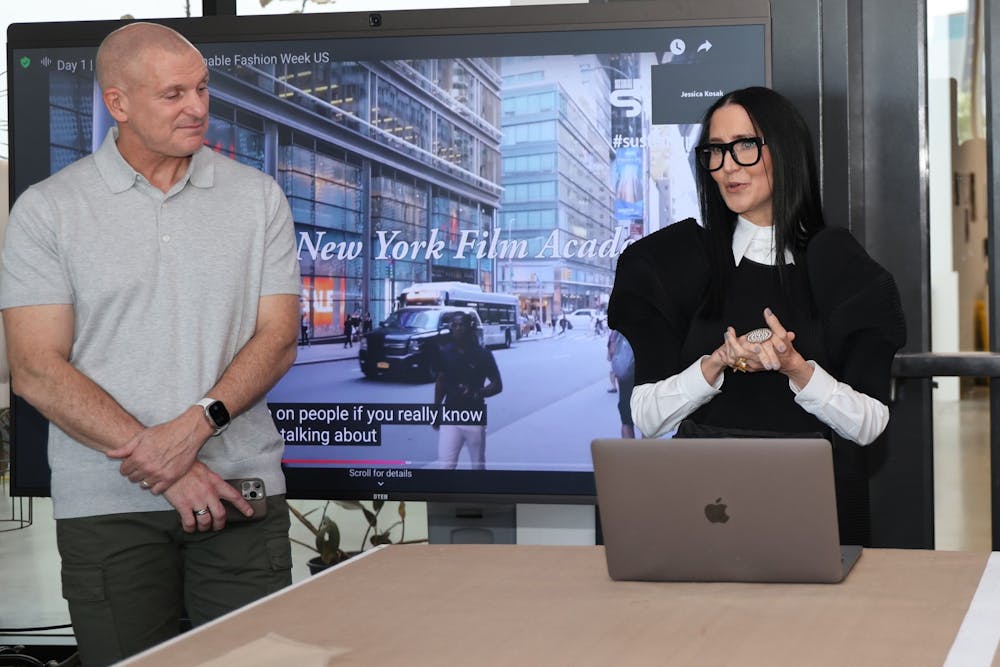In an era where clothing is getting cheaper and cheaper, people are owning more garments than ever before and consumerism is the hot topic discussed by everyone's favorite video essay YouTuber, new initiatives are emerging to challenge these unsustainable ideas.
The Box Project, spearheaded by graduate student Jill Stein, was part of Stein's research in fashion innovation with the College of Global Futures. The Box Project was created to challenge ASU FIDM students to rethink waste by working exclusively with dead stock materials donated by Supima Cotton and Arizona's Sustainable Fashion Week.
Students in professor Jessica Kosak's class, in collaboration with Stein's project, were tasked with creating innovative garments that not only reimagined fashion waste but would encourage viewers to rethink their consumer behavior. Kosak's students, along with Stein, created a website and public window display in Fusion on First to spread awareness about overconsumption.
"It's been a great journey," Stein said. "The collaboration with all the different disciplines and the different universities has been amazing ... seeing everyone come together under a unified vision is really fun."
The Box Project, propelled by a grant from the Humanities Lab called Beyond the Lab, helped Stein create an immersive display designed to help educate viewers about sustainable fashion practices. The display in Fusion on First took over 72 hours to create, as Stein used innovative technology that allowed viewers to see the student-designed garments in front of a screen.
"The whole idea was to educate not only ASU FIDM students, but also anyone that would be visiting Fusion on First would get an exposure to what sustainable fashion is and what the problems are driving it," Stein said.
The display showcased many of the realities of fast fashion, from exploitative labor practices to toxic dye runoff contaminating water supplies. After being inspired by the amount of packages found in high-rise delivery rooms and overflowing trash rooms, the project's central metaphor — the shipping box — was then used by Stein to highlight the excessive packaging and consumer habits driven by fast fashion.
"If you go to any building, especially high rise buildings, where people are collecting boxes, and they have a parcel pending system, and you look at the amount of boxes in the waste room, nine times out of ten those items are clothing," Stein said.
One of the core messages behind The Box Project was to encourage consumers to start putting friction between themselves and their purchases.
Participating students like Atticus Doan, a senior studying business sustainability with a minor in fashion, found the project inspiring. Doan said the project pushed his creativity and challenged him to think more about sustainable design practices.
"The limitations of the project, I think, fostered more creativity," Doan said. "It was really rewarding and I felt a sense of achievement in it, because when I initially got the box, I wasn't necessarily happy with the fabric that I had gotten and how little of it there was. And so it was really rewarding to try to design something that's outside of my comfort zone."
Lisa Shrigley, a faculty associate with ASU FIDM, praised Stein's vision. Shrigley acted as an advisor to Stein, helping with the logistics of producing a window display.
"I think what she presented to me was so compelling, not only from a conceptual perspective, but also she just did so much research, and she was incredibly thoughtful about not only how she was going to tell her story in a visual display, but how she was going to integrate the works of students to show her data," Shrigley said.
Stein's Box Project is a push forward in spreading awareness about the toll the fashion industry is having on the environment. The project does more than critiquing fashion's environmental impact — it proposes solutions as Stein advocates for up-cycling and consumer mindfulness.
"Just being in the fashion industry, when you get exposed to how the sausage is made, you really start to see the underbelly and how disturbing it is," Stein said. "I'm the kind of person where I have to do something about it. I also want to be on the right side of history."
Ultimately, The Box Project aims to spark a cultural shift.
READ MORE: Stop and cop: Top 5 places to thrift near ASU
"What needs to really seep into the zeitgeist is the idea of less is more, and putting friction in between yourself and purchases," Stein said.
As the fashion industry continues to grapple with its role in environmental damage, initiatives like The Box Project offer a hopeful glimpse into a more responsible future — one where fashion is not only beautiful but also sustainable.
Edited by Andrew Dirst, Abigail Beck and Katrina Michalak.
Reach the reporter at thutche1@asu.edu.
Like The State Press on Facebook and follow @statepress on X.
Tiffany is a freshman studying fashion design in business administration. This is her second semester with The State Press.




